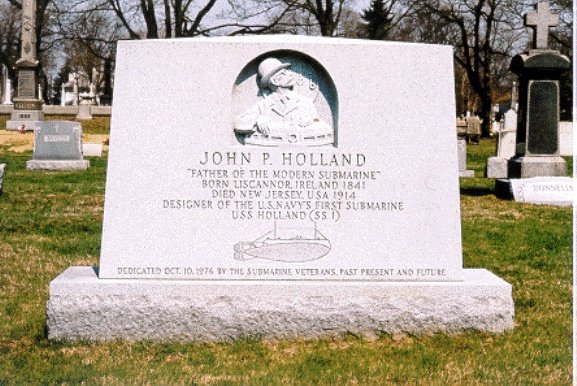John P.
Holland (1840 - 1914)
Teacher, Fenian, Engineer,
First submarine inventor
 John
Phillip Holland was born in Ireland in 1840 in Liscannor,
Co. Clare to an Irish speaking mother, Máire Ní
Scannláin and John Holland.
John
Phillip Holland was born in Ireland in 1840 in Liscannor,
Co. Clare to an Irish speaking mother, Máire Ní
Scannláin and John Holland.
He was educated by the Christian
Brothers in Ennistymon, where he excelled in science and
mathematics. After finishing school, he joined the
Christian Brothers and taught in numerous locations
throughout the country.
During his years in Ireland, he and
his brother, Michael, were both active in the Fenian
Movement. After six years he left the Christian
Brothers to pursue his dream of designing and building a
submersible vessel that could be used to sink British
warships. With no hope of implementing such an
audacious undertaking in Ireland, he left for the Unites
States in 1873 where he could pursue his dream.
After arriving in the U.S., he
worked as a teacher in New Jersey. During this period,
he submitted a submarine design to the United States
Navy, which was rejected. Despite that, Holland
continued to pursue his dream. Eventually, with
financial backing from the Fenian Brotherhood and other
private sources he designed a vessel equipped with
advanced ballast and propulsion systems, his sixth
design in 25 years.
Holland's prime purpose in
designing the submarine, named the Fenian Ram, was to
provide a significant naval advantage to the Fenian
Brotherhood in what was hoped would inflict a
significant blow to the Royal Navy, which had no defense
against an under-water attack.
In the end, it was the U. S. Navy
that first added the Fenians design as the world's first
under-water vessel equipped with torpedoes -- the U.S.S.
Holland (Submarine Torpedo Boat #1). It was built at
Elizabethport, NJ, and commissioned in 1900. It was the
precursor of today's many nuclear-powered submarines.
Though not a certified engineer nor
a professional sailor he was the first submarine
designer to successfully build an under-water warship
that could (a) dive quickly and (b)-- the elusive
element for all those before him -- emerge safely and
quickly to the surface when intended. The crews of other
"submarines" in war and peace had lost their lives
because of the absence of those last crucial elements --
to surface quickly and safely when required.
John Holland died in Newark, NJ on
12 August 1914 two weeks after the outbreak of the First
World War. Immediately after the war started,
"Holland-type" submarines from opposing sides began
sinking ships at a greater rate than even John Holland
himself could have predicted. His lifelong dream was
proved true, perhaps, not as he intended but,
nevertheless proven.
When Holland's remains were removed
from an obscure grave to be re-interred in 1976, among
those present for the ceremony were two flag officers
from the U. S. Navy and representatives from the
Electric Boat Company, manufacturer of today's U.S.
Navy's nuclear submarines.
The Fenian Ram -- the successful
design, and its much smaller, one-man prototype -- can
be seen today in the Paterson NJ Museum, just yards from
the Passaic River bridge where the prototype was rescued
from the river in the 1930s.
Submarines designed by John P. Holland
(Source Wikipedia)
-
Holland I – A small unarmed submersible. Now on
display at the Paterson Museum.
-
Holland II (named
Fenian Ram) – Built for Irish revolutionaries;
now on display at the Paterson Museum.
-
Holland III – Scaled down version of
Fenian Ram used for navigation tests.
-
Holland IV (known as the
Zalinski Boat) – experimental submarine financed
by US Army Lieutenant Edmund Zalinski.
-
Holland V (named
Plunger) – Prototype used to demonstrate
potential of submarines for naval warfare. Launched
in 1897 and used as an experimental submarine by the
US Navy. Returned to the Holland Company in 1903 and
scrapped in 1917.
-
Holland VI – First modern submarine in the
United States Navy. Launched in 1897. Acquired by US
Navy in 1900 and commissioned in 1900 as USS
Holland (SS-1). Decommissioned in 1905.
-
HMS
Holland 1 – First modern submarine in the Royal
Navy.
Contributed by;
Tomás Ó Coısdealbha
cemetery
AND
grave
location
Name:
Holy Sepulchre
Cemetery
ADDRESS:
52
Totowa
Rd,
Totowa,
NJ
07512
HEADSTONE
